Women in the Royal Canadian Air Force
In 1941 the Royal Canadian Air Force (RCAF) opened its doors to women with the creation of the Canadian Women's Auxiliary Air Force, renamed the RCAF Women's Division (WD). The airwomen primarily filled support jobs so "that men may fly." Prior to this, starting in 1939, women were only allowed to enlist as Nursing Sisters into the newly formed RCAF Medical Service. The RCAF (WD) was disbanded Dec 11, 1946. In 1951 women were accepted into the RCAF.
Featured Stories for Jewish Airwomen:
Norda Bennett (Berlin) / Diane Croll / Rose Goodman / Mary Iscove (Wolfe) Sue Jacobs (Ransohoff nee Westheimer) / Lillian Jacobs / Ziona Kaplan (Levin) / Sarah Lack (Cohen) / Lilia Logette / Roslyn Marcus (Grey) / Mollie Mickelson (Klein) / Esther Mendelsohn (Mager) / Esther Raber (Nobleman) / Frances Raitblat (Rothblatt) / Tanya Volovnik (Gelfand/Skar)
ESTHER MENDELSOHN
Married Name: Esther Mager
Birthplace: Montreal, December 3, 1917
Service Unit: RCAF (WD)
Job: Motor Transport Driver
Enlistment Date: 1941
Death Date: December 29, 2017
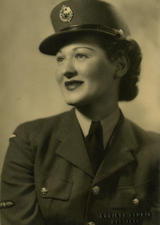
Photo courtesy of the Ontario Jewish Archives
Just nine months after Esther's birth, her mother passed away as a result of the 1918 flu epidemic. From the time she was 12, Esther helped out at her father's jewellery business. She later worked as an assistant bookkeeper for an appliance production business. In 1941 Esther enlisted in the Canadian Air Force and one of her initial postings was to the Bombing and Gunnery School at Mont-Joli, Quebec.
In her memoir recorded by The Memory Project, she noted that there were many crashes and that "nine times out of ten there were bodies when they crashed. So we had to go to pick up the pieces." The weather so bad that at one point she had to go to the hospital to "thaw out." During the winter, the snow was so deep that the snowploughs had to make routes for them so they could get to the places where the planes had crashed.
In 1945 she married Saul Mager, whom she had met while on a leave when she was stationed in North Battleford, Saskatchewan. While many servicewomen married men who were, or had been, in the military, Saul was a civilian.
Sources:
Bessner, Ellin. 2018. Double Threat: Canadian Jews, the Military and World War II. 103-112. Toronto: New Jewish Press.
Esther Mager fonds. Ontario Jewish Archives. Toronto Ontario.
Esther Mager in The Memory Project. Veterans Stories. Historica Canada (website).
ZIONA KAPLAN
Married Name: Ziona Levin
Birthplace: Winnipeg, January 19, 1925
Service Unit: RCAF (WD)
Rank: Leading Airwoman
Job: Medical Stenographer
Enlistment Date: 1942
Death Date: October 18, 2009
Ziona was raised in Winnipeg and on a farming colony in Grosse Isle, Manitoba. When she was in Grade 11, she left the farm and came to live with a sister in Winnipeg. At the age of 17, within months of arriving, she enlisted - both because of what was happening in Europe and for the excitement and adventure. For five months she kept her enlistment a secret so that no one would be able to try and talk her out of it. Her girlfriends were impressed that she was in the military but "none of them would have had the nerve to do what she had done." Posted to western Canada, she worked as a medical stenographer, travelling with doctors to different stations.
The air force was Ziona’s first exposure to making friends with non-Jews. Coming from an orthodox home, her military service was also the first time she tasted non-kosher food. For Passover she was invited to seders in Vancouver and Prince Rupert.
Her military training not only provided her with confidence but also with a useful trade. At war’s end she was able to find employment as a medical stenographer in a Winnipeg hospital. Ziona later married a veteran and raised three children.
Sources:
Chisvin, Sharon, ed. 1998. Women’s Voices: Personal Reflections, Volume 7, Jewish Life and Times. Winnipeg: Jewish Historical Society of Western Canada.
Levin, Ziona. 1986. Interview with Stuart Carroll, June 2, 1986. Jewish Heritage Centre of Western Canada, Winnipeg, Manitoba.
MOLLIE MICKELSON
Married Name: Mollie Klein
Birthplace: Edmonton, Alberta, October 24, 1912
Service Unit: RCAF (WD)
Rank: Sergeant
Job: Secretary
Enlistment Date: 1942
Death Date: September 30, 2005

Photo courtesy of the Jewish Archives and Historical Society of Edmonton and Northern Alberta (JAHSENA) jhse-69-is-jhse-712
Mollie joined the RCAF Women's Division in 1942 when it was called the Canadian Women's Auxiliary Air Force. She was bored with her job, wanted to do something for the war effort, and two of her brothers were already serving (both were wounded in battle - one in the Normandy invasion and the other in the Italian Campaign).
Sergeant Mollie Mickelson was involved in confidential correspondence during the three-plus years she worked as secretary to Captain Foss, Commanding Officer of the No. 9 Bombing and Gunnery School in Mont-Joli, Quebec, and in her subsequent posting with Captain Foss in Prince Rupert, British Columbia. Mollie served in a battle zone, as her posting to Prince Rupert was considered a theatre of war due to the Japanese occupation of Attu in the nearby Aleutian Islands.
In Prince Rupert, Mollie had her first encounter with racism; she went to a movie and was told she could not sit on a particular side, as it was for aboriginals only.
Mollie was discharged in 1946. She later married George Klein, a Holocaust survivor, and raised a daughter.
Artwork inspired by Mollie's story.
Sources:
Coyle, Brendan. 2002. War on Our Doorstep: The Unknown Campaign on North America's West Coast. Victoria: Heritage House. (good overview of the battle over the Aleutians)
Klein, Mollie Mickelson. 1978. Summary of interview by Cyril Leonoff, June 15, 1978. Vancouver: JHSBC Oral History Collection, Jewish Museum and Archives of British Columbia. Reference number: A. 1971.001-19.78-01
Klein, Mollie Mickelson. 1999. Interview by Jean Gerber, Vancouver: JHSBC Oral History Collection, Jewish Museum and Archives of British Columbia.
Leonoff, Cyril Edel. 1978. Pioneers, Pedlars, and Prayer Shawls: The Jewish Communities in British Columbia and the Yukon. Victoria: Sono Nis Press. (see page 177)
Obituary. Vancouver Sun. October 8, 2005
ESTHER RABER
Married Name: Esther Nobleman
Birthplace: Estuary, Saskatchewan, January 19, 1921
Service Unit: RCAF (WD)
Rank: Sergeant
Job: Clerk Administrative
Enlistment Date: 29 April, 1943
Discharge Date: January 12, 1945
Death Date: June 6, 2014
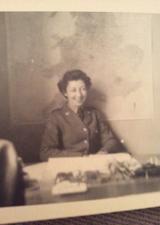
Photo courtesy Ellin Bessner
Born in Saskatchewan, Esther grew up in Medicine Hat, Alberta. According to Esther’s oral history, ninety percent of the young people in Medicine Hat volunteered for service. At least for young women, this appears to be accurate, with no less than five Jewish women from Medicine Hat enlisting. With a total Jewish population of ninety-three in 1941, this rate of enlistment was ten times higher than the general response rate for Canadian women, which was just under one percent of the 1941 female population. Perhaps the presence in Medicine Hat of an air force school that was training Commonwealth airmen from around the world was one reason so many youth from the area signed up for military service. The Royal Air Force No. 34 Service Flying Training School (SFTS) was opened in Medicine Hat in early 1941. Esther's family welcomed into their home Jewish servicemen from around the world training at the school.
As soon as she completed high school, Esther moved from Medicine Hat to Ottawa to join the civil service. She worked as a secretary in the Department of Munitions and Supplies. This department was involved in "top secret" work including the development of landing craft utilized in the allied invasion. Despite being involved in the war effort, Esther noted "I did not feel I was doing enough." She was committed to joining the military, following in the footsteps of her brother and other Jewish girls from Medicine Hat.
Over her parents' objections, Esther enlisted in the spring of 1943. While her goal was to be a wireless operator working overseas, she served as a secretary, stationed in Ottawa at Air Force headquarters. Esther worked in The Directorate of Technical Training. She rose quickly through the ranks and was one of the youngest to receive sergeant's stripes. As a sergeant she was assigned to night-watch duty guarding a floor of the Air Force headquarters which held "top secret" radar files. Her brother Manuel, who enlisted in the RCAF in 1939, was shot down over Belgium in November 1943 on his thirty-first mission and ended up in Stalag Luft III prisoner-of-war camp. When Esther heard that Manuel was "missing in action; presumed dead," she was "more determined than ever" to get an overseas posting. While she made numerous requests to be posted overseas, she remained in Ottawa for the duration of her service.
After the war Esther married Abe Nobleman whom she met on a group date with ex-servicemen. They initially lived in Montreal, followed by Medicine Hat and then Vancouver. The decision to move to Vancouver was influenced by the fact that Abe had been stationed in the area. Prior to having her family (she had three children), Esther worked in the legal profession. While raising a family, she assisted Abe in his ladies wear shop and together they created successful businesses in Medicine Hat and Vancouver. In her oral history, Esther notes that during her fifteen years of married life in Medicine Hat, she also worked as the interviewer for a nightly radio interview program called Assignment. In 1976, at the age of 55, Esther graduated from the University of British Columbia with a Bachelor of Arts majoring in English and Fine Arts.
Artwork inspired by Esther's story.
Sources:
Bessner, Ellin. 2018. “Jewish Women in Uniform.” In Double Threat: Canadian Jews, the Military and World War II. 103-112. Toronto: New Jewish Press.
"Degree Earned." Medicine Hat News. June 7, 1976, 6
Nobleman, Esther. 2014. Esther Nobleman Oral History. 2014. The Jewish Museum and Archives of British Columbia, Vancouver.
Nobleman, Esther Raber. "The Battle of Ottawa." (unpublished document on her military experience received from Esther's family)
Raber, Manuel. 1999. Manny Goes to War: The War Memoir of Manuel Raber. Medicine Hat: M Raber.
Ramsey, Cynthia, ed. 2015/16. "JMABC Collection: Oral History Excerpts – The Clothing Industry: Esther Nobleman." The Scribe: The Journal of the Jewish Museum and Archives of British Columbia 35:125-129.
TANYA VOLOVNIK
Married Name: Tanya Gelfand / Sklar
Birthplace: Winnipeg, Manitoba, April 21, 1919
Service Unit: RCAF (WD)
Job: Clerk Stenographer
Death Date: January 1, 2009

Photo courtesy of the Jewish Historical Society of Southern Alberta. JHSSA #2378.
Tanya grew up in Calgary and appears to have been the only Jewish woman from Calgary to join the RCAF Women's Division. Tanya, in her 1999 oral history, reported that she was one of the first 2,000 Canadian airwomen.
As a clerk steno she served across Canada for two and half years including secretarial work for the Wing Commander of the British Commonwealth Air Training Plan, the body responsible for training airmen throughout the Commonwealth. She did her basic training in Toronto and then spent some time at the Dauphin, Manitoba, flying school, ending her service at headquarters in Winnipeg. She found it difficult to make friends while in the military and felt some degree of racism.
After the war she graduated from the University of Toronto Business School with a Bachelor of Commerce. In 1950, she married RCAF veteran Robert Gelfand and settled in Calgary where she raised three sons and worked as a freelance writer. When she became a widow in the 1960s, she began hosting live television (cooking and sewing) and radio (talk show Forum) programs and doing commercials. She was one of the first women hired as a media host. Tanya was an active volunteer with many organizations including Calgary Cable, Glenbow Museum, Calgary Chinatown Lioness Club and the Olympic Arts Festival.
Sources:
Karshenbaum, Irena. 2010. “Tanya Volovnik Gelfand Sklar: A Woman Ahead of her Time." Discovery: The Journal of the Jewish Historical Society of Southern Alberta 20, no. 1: 1-2,6.
Sklar, Tanya (Volovnik). 1999. Interview with Bertha Gold. November 23, 1999. The Jewish Historical Society of Southern Alberta, Calgary. (transcript)
SUE JACOBS
Maiden Name: Sue Westheimer
Married Name: Sue Jacobs/Sue Ransohoff
Birthplace: Baltimore, December 22, 1919
Service Unit: RCAF (WD)
Enlistment Date: Fall 1943
Death Date: March 20, 2020
On July 23, 1941, American Sue Westheimer married Pilot Officer Michael Jacobs whom she had met at an American college. Michael had enlisted with the RCAF in 1940. One and a half years after their marriage, Michael, the second navigator, along with the rest of his crew was killed as a result of a plane-part failure during a routine navigation exercise in England. It was her husband’s death that spurred Sue to enlist. After his death, she went to Montreal to visit with his family. While there, she learned that there was a women’s division in the RCAF, and she immediately made the decision to sign up.
She trained in specialized flying control and was posted to Gander, Newfoundland air force base, working in the control tower with flying control where she kept track of incoming and outgoing planes. At the time, planes did not have the capacity to fly from North America to Europe without refuelling in Gander. Sue was posted at Gander for about a year and half. In an interview, she remarked, “Never any doubt in my mind that we were fighting a necessary and just war.” At the time, Newfoundland was not part of Canada but was a colony of Great Britain, so postings to the area meant servicewomen were being sent outside of Canada.
After Gander, she was transferred to Scoudouc, New Brunswick. Shortly afterwards, she was released from the military, marrying her second husband, Jerry Ransohoff, just before her discharge. Jerry served as a historical officer with the United States 11th Air Force. Sue's brother Julius also served in the United States Army.
After the war, Sue returned to the United States, where she and Jerry raised four children. Because she had enlisted in the Canadian Armed Forces, Sue lost her American citizenship, but in 1946 her US citizenship was restored. She graduated with a Masters in Social Work and enjoyed a long career as a social worker. Sue also worked as a reviewer and journalist. Sue recently passed away at the age of 100.
Sources:
Archive Report: Allied Forces.
Bessner, Ellin. 2018. “Jewish Women in Uniform.” In Double Threat: Canadian Jews, the Military and World War II. 103-112. Toronto: New Jewish Press.
"Citizenship Restored to Reporter's Wife." The Cincinnati Enquirer, May 14, 1945, 15.
Interview with Sue Ransohoff, Veterans History Project. Public Library of Cincinnati and Hamilton County, Cincinnati, Ohio. (video interview detailing information about her military service)
Obituary. Cincinnati Enquirer, March 27, 2020. (viewed in Legacy.com)
“Sue Ransohoff, American Israelite Book Reviewer." The American Israelite, April 2, 2020, 1.
SARAH LACK
Married Name: Sarah Cohen
Birthplace: Winnipeg, 1913
Service Unit: Royal Canadian Air Force Medical Branch
Rank: Lieutenant / Nursing Sister
Enlistment Date: 1940
Discharge Date: 1946
Death Date: December 23, 1990

Photo courtesy of the Western Jewish Heritage Centre
Sarah was anxious to contribute to the war effort but experienced difficulty getting into the air force as she was very short, two inches under the minimum height requirement. Her graduation from nursing school in 1936 with the highest grades helped to get her accepted despite her short stature. She initially wanted to enlist in the medical corps as soon as the war started, but due to her mother's serious health issues, she delayed joining the service until after her mother passed away.
First posted to the hospital at the McDonald Bombing and Gunnery School, she also spent time in Newfoundland and Ottawa before being sent overseas in 1941. She had previously been selected for an air evacuation course in the United States, which trained in how to carry injured people from a war zone, how to construct a temporary camp, and how to identify various types of planes.
In October 1941, Sarah was sent overseas to the orthopedic ward in an RAF hospital in North Allerton, Yorkshire. She noted that “you could count the number of boys who had two arms and two legs in the single digits." While in England, she also saw first-hand the blackouts, bombing and food shortages that the citizens of England had to deal with. From North Allerton, Sarah was transferred to a medical facility in the English seaside resort town of Torquay, where she was in charge for a period of time.
She returned home on March 13, 1946. Nobody seemed to be interested in hearing about her war experiences. The friends and family that Sarah encountered on her return seemed unaware of what had really happened overseas. They were living their lives as they did before the war. Sarah married a fellow veteran in September 1946, raised two children, and only returned to nursing when her children were adults.
Sarah was proud of her service and spoke of her war experiences with her children. The military gave her confidence and helped her grow as a person.
Artwork inspired by Sarah's story.
Sources:
Cohen, Sarah. 1986. Interview by Stuart Carroll, July 7, 1986, Jewish Historical Society of Western Canada, Winnipeg.
Chisvin, Sharon, ed. 1998. Women’s Voices: Personal Reflections, Volume 7, Jewish Life and Times. Winnipeg: Jewish Historical Society of Western Canada. (includes selections from the oral history of Sarah Lack (Cohen) recorded by the Jewish Historical Society of Western Canada)
NORDA BENNETT
Married Name: Norda Berlin
Birthplace: Toronto, March 24, 1923
Service Unit: RCAF (WD)
Enlistment Date: 1943
Death Date: June 10, 1999
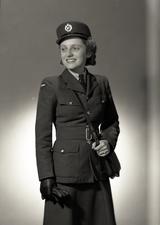
Photo courtesy of the Ontario Jewish Archives
Norda began an honors program in Philosophy and English at the University of Toronto in 1941, but in 1943 she interrupted her studies to join the RCAF. Norda may have been encouraged to volunteer for service because of her parents’ leadership in the Jewish community. Her father was President of the Central Division of Canadian Jewish Congress and her mother was Vice-Chair of the Women’s War Efforts Committee of Canadian Jewish Congress. After the war she continued her studies at the University of Toronto and worked as a librarian.
Artwork inspired by Norda's story.
Sources:
"Canadians in the War." Canadian Jewish Review, June 25, 1943, 3
"Jews in Uniform." Jewish Western Bulletin, July 23, 1943, 2
Norda Bennett. Sylvia Schwartz fonds. Ontario Jewish Archives, Toronto
ROSLYN MARCUS
Married Name: Roslyn Grey
Birthplace: Saint John, New Brunswick, April 17, 1925
Service Unit: RCAF (WD)
Rank: LAC
Job: Wireless Operator Ground
Enlistment Date: December 27, 1943
Discharge Date: June 16, 1945
Date of Death: October 29, 2020
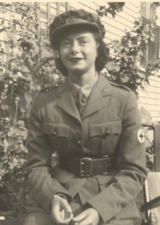
.
Photo courtesy of Roslyn Marcus's Family
Roslyn (Lyn) started her post-secondary education at Dalhousie University, but, in part to escape antisemitism, later transferred to Queen’s. However, at Queen’s she also experienced antisemitism, specifically men on campus during the war years being labeled “Jewish cowards and pacifists.” This experience spurred Roslyn to enlist in 1943. Before she enlisted in the Air Force, Roslyn volunteered as a driver for the Red Cross. After completing training as a wireless operator, she was stationed in Montreal, Hamilton, Halifax and finally Dartmouth, Nova Scotia.
At discharge, Roslyn was approved for university training. Under the Veterans Rehabilitation Act she received a living allowance, paid tuition and access to student loans. Roslyn returned to Queen's University to complete a BA in Biology and Chemistry followed by a MA in Microbiology. During her MA studies she worked as a Research Assistant for the Defence Research Board. Upon completing her MA in 1950, Roslyn accepted a three-year position as a Research Scientist at the Medical Research Council of Great Britain in London. She spent the following few years moving between Canada, England and Europe. In 1963, Roslyn was Chairman of the Consumers' Association of Canada's Committee on Pesticides. Roslyn initially held a number of temporary part-time positions at a variety of Ottawa post-secondary institutions. From 1967 until her retirement in 1985 she worked at Carleton University. She began her career at Carleton as a Laboratory Supervisor and Sessional Lecturer in biology and in 1978 Roslyn received a permanent appointment as an Instructor. Roslyn was briefly married directly after her discharge from service. In 1952, she married her second husband Rodney Grey (divorced 1970), they had two children. George Setterfield was Roslyn's long-term partner until his death in 2008.
Sources:
Correspondence from Roslyn Grey's family
McKenzie, Judith. 1999. Pauline Jewett: A Passion for Canada. Montreal: McGill-Queen’s University Press.
Service files. (copy provided by her family)
ROSE GOODMAN
Birthplace: New Glasgow, Nova Scotia, June 19, 1919
Service Unit: RCAF (WD)
Rank: Section Officer
Job: Adjutant
Enlistment Date: October 1941
Death Date: January 26, 1943
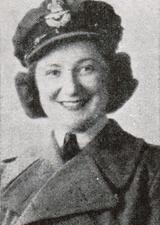
Photo courtesy of the Alex Dworkin Canadian Jewish Archives
RCAF Women’s Division Section Office Rose Goodman was the only Jewish servicewoman to die during the war. On January 26, 1943, Rose was maid of honour for the marriage of two officers from her Claresholm base. The newlyweds were at risk of missing their honeymoon flight to Vancouver due to a schedule change, so the best man offered to fly them to the Lethbridge airport and Rose joined her friends on the plane. On the return flight from Lethbridge to Claresholm, limited visibility and a plane malfunction resulted in the plane crashing in a farmer's field. While the pilot, who survived, claimed that they had authorization to use the aircraft, the military did not concur. A report was sent to Ottawa indicating that Rose did not have permission to be on the plane.
Rose enlisted in the fall of 1941 after graduating from Dalhousie University with a Bachelor of Arts. It was in 1941 that the air force first opened their doors to women with the creation of the women’s section called the Women’s Auxiliary Air Force (later renamed RCAF Women's Division (WD)). At enlistment she was recognized as having officer potential. She was part of the first cohort of the Administrative Training Course. She received excellent evaluations and rose quickly through the ranks. In 1942 she was recommended for appointment as Assistant Section Officer and posted to No. 6 Training Depot in Trenton, Ontario, shortly thereafter she was assigned to Number 15 Service Flying Training School in Claresholm, Alberta, where she served as Adjutant until her untimely passing in January 1943.
In December 1942, Claresholm Training School had over 1200 RCAF officers, airmen, airwomen and trainees as well as over 70 civilians.
Sources:
Bessner, Ellin. 2018. Double Threat: Canadian Jews, the Military and World War II. Toronto: New Jewish Press.
Daily Reports No. 15 Service Flying Training School, Claresholm, AB. Commonwealth Air Training Plan Museum Research Project. (website)
Goodman, Rose. Canadian Jewish Congress Organizational Fonds. Alex Dworkin Canadian Jewish Archives, Montreal.
"Remembering World War II. Rose Jette Goodman," Wartime Heritage Association. (website)
Rome, David ed. 1947. Canadian Jews in World War II. Part 2, Casualties. Montreal: Canadian Jewish Congress.
Rose Goodman Service File. Library and Archives Canada.
"Section Officer Rose Jette Goodman,"Canadian Virtual War Memorial. Veterans Affairs. (website)
DIANE CROLL
Birthplace: Yorkton, Saskatchewan, December 24, 1914
Service Unit: Royal Canadian Air Force, Medical Branch
Rank: Temporary Flight Officer
Job: Doctor
Enlistment Date: July 4, 1942
Death Date: July 29, 1974
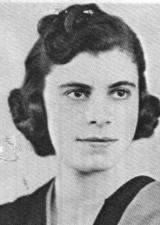
Photo from Diane's Service File Records
Diane received her MD from University of Manitoba in 1940. She followed her internship with a Masters of Science in Experimental Medicine. She enlisted in June of 1942 and served at several bases in Ontario, including Rockcliffe and Trenton.
While a proficient doctor, she did have difficulty adjusting to the strict environment of the military. One of Diane's military reports noted “her indifferent attitude towards 'the spit and polish' of military life.” Another remarked, “this officer does an excellent job if she can work 'on her own.' Appears a little resentful of direction and exhibits some difficulty in fully adapting herself to accepted service procedure.”
Diane resigned from the service on November 29, 1944 and was released on December 13, 1944. She later went on to have a distinguished career in pathology and internal medicine. In 1977 her sisters established the Diane Croll Memorial Scholarship at the University of Winnipeg in her memory.
Sources:
“Gift to Winnipeg Associates in Aid of Scholarship-Fund of Ben-Gurion U.” Jewish Post, September 1, 1977, 6.
Service File for Diane Croll. Library and Archives Canada, Ottawa
LILIA LOGETTE
Birthplace: Argentina, October 27, 1911
Service Unit: RCAF (WD)
Enlistment Date: 1942
Death Date: September 28, 2002
At the age of 14, Lilia sailed from Liverpool to Canada with her 12 year old sister and their family's 25 year old domestic worker. They travelled on the Montclare and its passenger list for February 14, 1926, indicated that Lilia's profession was "scholar" and that she was born in Buenos Aires but was Irish. They arrived at St. John and then joined their parents who had previously settled in Montreal.
Lilia's parents were British. Her father worked in the Chief Engineer's Department of the Argentine office of the Buenos Ayres and Pacific Railway Company. Lilia had a very varied career. In the 1930s she was involved in the music industry. In 1936 she and Arthur Field applied for a patent on a musical work.
In 1942 she enlisted in the RCAF Women's Division, following in the footsteps of her father Albert Logette who not only served in the British Army Service Corps in World War I, but also served in the Royal Canadian Navy Volunteer Reserves during the Second World War. In 1946 Albert was promoted to Commander, making him likely the highest-ranking Jewish naval officer.
After the completion of her military service, Lilia studied interior design in New York. In the mid-1950s she was involved in the restaurant business and then in the 1970s, established the Center for Human Development in Hollywood, Florida. In a tribute to her after her death, she was described as a “third generation psychic” involved in “metaphysical and spiritual healing.” Lilia had two PhDs.
Sources:
Anglo-Argentine Railwaymen Who Served in the Great War, 1914-1918. (website)
Canadian Passenger Lists, 1865-1935. viewed in Ancestry.com
“Lilia Logette, 90, Psychic Healer”. South Florida Sun Sentinel, October 2, 2002.
Obituary. Sun Sentinel, October 2, 2002. (viewed in Legacy.com)
"Royal Canadian Navy Promotes 219 Officers and 16 Women." Ottawa Journal, January 1, 1946, 20.
Frances Raitblat
Married Name: Frances Rothblatt
Birthplace: Calvert, Texas, June 22, 1909
Service Unit: RACF (WD)
Rank: Section Officer
Death Date: May 29, 1982
Frances is an example of a servicewoman for whom information about her service is only gleaned from her brother Norman’s record. Sadly, Flight Sergeant Norman Raitblat died during air operations over Hamburg on November 9, 1942. His last flight marked just under one year as a Wellington bomber pilot. His entry in the list of Canadian Jewish casualties published in Canadian Jews in World War II, notes his sister’s service.
Frances was born in Texas but her family moved to Toronto sometime before her brother's birth in 1919. In 1940 Frances was working as a stenographer in Toronto. After the war she moved to Chicago and in 1947 married Sidney Rothblatt. When her father became a naturalized Canadian citizen in 1922, Frances too was naturalized and lost her American citizenship. In 1949 she submitted a petition to the State of Illinois to regain her American citizenship.
Sources:
Ancestry.com
Frances Adele Rothblatt (Raithblat). geni.com. (website)
Rome, David ed. 1947. Canadian Jews in World War II. Part 2, Casualties. Montreal: Canadian Jewish Congress. (Information is reprinted online)
MARY ISCOVE
Married Name: Mary Wolfe
Birthplace: Toronto, December 5, 1917
Service Unit: RCAF (WD)
Rank: Corporal
Job: Role: Clerk General
Enlistment Date: September 30, 1942
Death Date: January 18, 2009
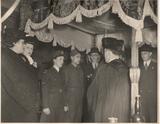
Photo courtesy of Mary Iscove's family
Mary did not inform her parents that she was enlisting and they were very upset that she had signed up. After basic training in Ottawa, she was posted to London, England. According to her daughter, Mary often remarked that “the “girls” who got to go overseas were considered the ‘lucky few.”
She left for England on March 20, 1943, in a convoy of ships, many of which, including hers, were not originally built for north Atlantic voyages. In London she was assigned to the Records Division, where she was involved with the files of missing airmen, trying to put together all available information. Every time there was a “doodlebug” bombing she had to grab her work and race to the air-raid shelter. In London, she was connected to a Jewish family where she spent her leaves. This connection became a lifetime friendship and she later took her children to meet the London family.
She met her husband in England. He was also from Toronto, but they did not know each other in Toronto. Her future husband was in the army and was told by relatives to look up Mary when he was transferred to London. Shortly after meeting, they were married in London on October 10, 1943 at Golders Green Synagogue. Mary continued to serve until 1945.
Sources:
Correspondence from Mary Iscove's family.
Lillian Jacobs
Service Unit: RCAF (WD)
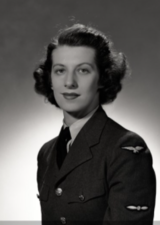
.
Photo courtesy of Ontario Jewish Archives
Lillian Jacobs is another example of a servicewomen for whom information is very sparse. In Lillian's case, her service in the RCAF WD was identified through the listing of her name in the nominal rolls compiled by the Canadian Jewish Congress and her portrait photograph in uniform. This photograph taken in 1943, is part of a series of Jewish military portraits created in the 40s by portrait photographer Sylvia Schwartz. On the back are some comments by Lillian, "What do you think of this? I am not sure. The more I look at it the better I like it. Get one of these only see that the hair at the back is fixed."
Artwork inspired by Lillian's story.
Sources
Lillian Jacobs - 1943. Sylvia Schwartz fonds. Ontario Jewish Archives, Toronto
Nominal rolls. Alex Dworkin Canadian Jewish Archives. DA 18.1 box 16 file 2/14
